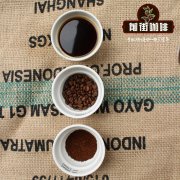Espresso full fat or skim coffee milk full fat or skim

Professional coffee knowledge exchange more coffee bean information please follow the coffee workshop (Wechat official account cafe_style)
Espresso and milk are a perfect match. The former has fruity, caramel and chocolate flavors, while the latter is a healthy daily drink with taffy, chocolate and dried fruit flavors derived from the mixture. It's really a drink that you don't want to stop after drinking. Espresso with milk is an ideal breakfast substitute for many people, providing the calories and major minerals needed in the morning.
From sprinkling milkshakes in espresso to breaking into a cup to soften the foam or milk coat of pure espresso, espresso and milk are available in a wide range of ways. Today, most of the coffee drinks served in cafes are actually milk. To be honest, some coffee chains are increasingly adept at masking the flavor of coffee with frightening amounts of milk and extra seasonings (usually sweeteners). But then again, even in boutique cafes, milk is very important to the quality of the finished product, as a part of the drink, it is elegant and delicate, at the same time, it is an important intermediate to control the temperature of the drink.
Espresso is not the beginning of all this, let alone the end. You may not expect that humans have been mixing coffee and milk for about 300 years.
History: the close relationship between Coffee and Milk
Coffee and milk (or cream) have always been natural companions. People began to put them together as early as the 18th century. But this is not to enjoy its own taste, at the time, only children, the elderly and the sick would drink the drink. For the same reason, mixed drinks of milk and tea also sprang up at the same time. Aren't you feeling well? Put some milk in your coffee. Later, people began to add cream to the coffee, gradually creating a casual drink.
In 1727, James Douglas, a British historian, wrote that many people dislike the bitterness of black coffee and prefer to "add sugar or milk to it". Tristram Shandi, the eponymous protagonist of Lawrence Stern's comedy novel published in the 1860s, is particularly fond of drinking "two cups of coffee milk", saying the drink is "worth paying for." But milk and coffee must be boiled together, otherwise coffee is still coffee, milk or milk.
Milk is an emulsion composed of fat spheres and mixtures of minerals, proteins, acids, sugars and salts. Whey protein and β-lactoglobulin control the fat sphere and suspend it in water, making milk a stable substance. The mixture of fat and water makes the milk opaque, and the refraction of the emulsion to light makes it look blurred.
The milk you drink is almost certainly pasteurized. Pasteurization can kill 99.999% of the bacteria and prolong the shelf life of milk products from 3 days to about 3 weeks. The standard pasteurization, high-temperature short-term disinfection (HTST), quickly heats milk to 72 ℃ and lasts for 15 seconds to kill bacteria. Pasteurization, of course, has its drawbacks. It destroys part of whey protein in milk and reduces mineral content.
Many milk brands also need to be homogenized. When the flowing milk is baked and heated in a very fine tube, the fat molecules break down into small particles. The proteins in the milk fix these small particles and keep them in a state of emulsion. After these processes, the milk becomes silky and smooth; although it tastes worse than unhomogenized milk, it is fortunately no longer delaminated. I'm not very old, so I still remember that unhomogenized bottled milk often blocks the neck of the bottle because of the delamination of milk fat.
Whole milk contains 3.25 to 3.5% fat and skim milk contains about 1%. A standard latte requires about 150 milliliters of milk, that is, making lattes from whole milk and skim milk with 5 grams and 1.5 grams of fat, respectively, which means a difference of 3.5 grams per serving of coffee. By analogy, a packet of 150 grams of nuts contains 70 grams of fat, which is 20 times the fat difference between full-fat and nonfat lattes. And the latest research also shows that the less milk is processed, the healthier it is, and it has nothing to do with fat content.
Some milk is naturally low-fat milk. New Zealand cows are selectively fed, so the milk directly from the breast is low-fat milk with 1% fat.
Important Notice :
前街咖啡 FrontStreet Coffee has moved to new addredd:
FrontStreet Coffee Address: 315,Donghua East Road,GuangZhou
Tel:020 38364473
- Prev

What kind of milk is used in fancy coffee? what kind of milk is used in pull-flower coffee?
Professional coffee knowledge exchange more information about coffee beans Please follow the coffee workshop (Wechat official account cafe_style) the milk produced by each farm has different fat, protein content and different grades of sweetness. The actual quality of milk depends on the food that cows eat every day, as well as their daily growing environment, and how the milk is collected and stored and processed. Which kind of milk is suitable for production
- Next

A probe into Italian Coffee: why Coffee should be foamed and foamed
Professional coffee knowledge exchange more coffee bean information Please follow the coffee workshop (Wechat official account cafe_style) [fancy coffee], which refers to coffee with different condiments, such as milk, cream, chocolate, ice cream, all kinds of wine, juice and so on, based on espresso. It can be compared to a coffee symphony. Such as cappuccino, latte, mocha coffee
Related
- Beginners will see the "Coffee pull flower" guide!
- What is the difference between ice blog purified milk and ordinary milk coffee?
- Why is the Philippines the largest producer of crops in Liberia?
- For coffee extraction, should the fine powder be retained?
- How does extracted espresso fill pressed powder? How much strength does it take to press the powder?
- How to make jasmine cold extract coffee? Is the jasmine + latte good?
- Will this little toy really make the coffee taste better? How does Lily Drip affect coffee extraction?
- Will the action of slapping the filter cup also affect coffee extraction?
- What's the difference between powder-to-water ratio and powder-to-liquid ratio?
- What is the Ethiopian local species? What does it have to do with Heirloom native species?

